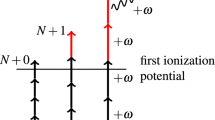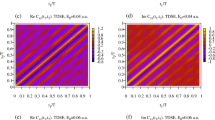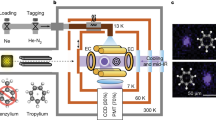Abstract
The way in which atoms and molecules are ionized by the impact of charged particles has important consequences for the behaviour of many physical systems, from gas lasers to astrophysical plasmas. Much of our understanding of this process has come from ionization measurements of the energy and angular distribution of electrons ejected in the same plane as the trajectory of the incident ionizing beam. Such studies suggest that the mechanisms governing the ionization of atoms and molecules are essentially the same. But by measuring the electrons ejected from a gas in a plane perpendicular to the incident beam, we show this is not always the case. Experiments and quantum mechanical calculations enable us to construct a remarkably accurate classical picture of the physics of charged-particle ionization. This model predicts that the differences in ionization behaviour arise in molecules that do not have nuclei at their centres of mass.
This is a preview of subscription content, access via your institution
Access options
Subscribe to this journal
Receive 12 print issues and online access
$209.00 per year
only $17.42 per issue
Buy this article
- Purchase on Springer Link
- Instant access to full article PDF
Prices may be subject to local taxes which are calculated during checkout






Similar content being viewed by others
References
Dürr, M., Dimopoulou, C., Najjari, B., Dorn, A. & Ullrich, J. Three-dimensional images for electron-impact single ionization of He: Complete and comprehensive (e,2e) benchmark data. Phys. Rev. Lett. 96, 243202 (2006).
Casagrande, E. M. S. et al. New coplanar (e,2e) experiments for the ionisation of He and Ar atoms. J. Electron Spectrosc. Relat. Phenom. 161, 27–30 (2007).
Lower, J. R., Bellm, S. & Weigold, E. An improved double-toroidal spectrometer for gas phase (e,2e) studies. Rev. Sci. Instrum. 78, 111301 (2007).
Deharak, B. A. & Martin, N. L. S. An out-of-plane (e, 2e) spectrometer using a movable electron gun. Meas. Sci. Tech. 19, 015604 (2008).
Bray, I. & Stelbovics, A. Explicit demonstration of the convergence of the close-coupling method for a Coulomb three-body problem. Phys. Rev. Lett. 69, 53–56 (1992).
Rescigno, T. N., Baertschy, M., Isaacs, W. A. & McCurdy, C. W. Collisional breakup in a quantum system of three charged particles. Science 286, 2474–2479 (1999).
Colgan, J., Pindzola, M. S., Robicheaux, F. J., Griffin, D. C. & Baertschy, M. Time-dependent close-coupling calculations of the triple-differential cross section for electron-impact ionization of hydrogen. Phys. Rev. A 65, 042721 (2002).
Bray, I., Fursa, D. V. & McCarthy, I. E. Convergent close-coupling method for electron scattering on helium. J. Phys. B 27, L421–L425 (1994).
Murray, A. J. & Read, F. H. Evolution from the coplanar to the perpendicular plane geometry of helium (e,2e) differential cross sections symmetric in scattering angle and energy. Phys. Rev. A 47, 3724–3732 (1993).
Murray, A. J. & Read, F. H. Low energy (e, 2e) differential cross section measurements on neon from the coplanar to the perpendicular plane geometry. J. Phys. B 33, L297–L302 (2000).
Rasch, J., Whelan, C. T., Allan, R. J., Lucey, S. P. & Walters, H. R. J. Strong interference effects in the triple differential cross section of neutral-atom targets. Phys. Rev. A 56, 1379–1383 (1997).
Stelbovics, A. T., Bray, I., Fursa, D. V. & Bartschat, K. Electron-impact ionization of helium for equal-energy-sharing kinematics. Phys. Rev. A 71, 052716 (2005).
Milne-Brownlie, D. S., Foster, M., Gao, J., Lohmann, B. & Madison, D. H. Young-type interference in (e, 2e) ionization of H2 . Phys. Rev. Lett. 96, 233201 (2006).
Murray, A. J. (e, 2e) ionization studies of alkaline-earth-metal and alkali-earth-metal targets: Na, Mg, K, and Ca, from near threshold to beyond intermediate energies. Phys. Rev. A 72, 062711 (2005).
Srivastava, M. K., Kumar, R. C. & Srivastava, R. Coplanar doubly symmetric (e, 2e) process on sodium and potassium. Phys. Rev. A 74, 064701 (2006).
Schulz, M. et al. Three-dimensional imaging of atomic four-body processes. Nature 422, 48–50 (2003).
Murray, A. J., Woolf, M. B. J. & Read, F. H. Results from symmetric and non-symmetric energy sharing (e, 2e) experiments in the perpendicular plane. J. Phys. B 25, 3021–3036 (1992).
Ward, S. J. & Macek, J. H. Wave functions for continuum states of charged fragments. Phys. Rev. A 49, 1049–1056 (1994).
Gao, J., Peacher, J. L. & Madison, D. H. An elementary method for calculating orientation-averaged fully differential electron-impact ionization cross sections for molecules. J. Chem. Phys 123, 204302 (2005).
Gao, J., Madison, D. H. & Peacher, J. L. Distorted wave born and three-body distorted wave born approximation calculations for the fully differential cross section for electron impact ionization of nitrogen molecules. J. Chem. Phys. 123, 204314 (2005).
Zhang, X., Whelan, C. T. & Walters, H. R. J. Energy sharing (e,2e) collisions-ionisation of helium in the perpendicular plane. J. Phys. B 23, L173–L178 (1990).
Acknowledgements
We thank the EPSRC (UK) for supporting these experiments, and the NSF for support of the theoretical work under grant No. PHY-0757749.
Author information
Authors and Affiliations
Contributions
O.A.-H. and D.M. carried out the theoretical calculations for this work, whereas C.K. and A.M. carried out the experimental investigations that are presented.
Corresponding authors
Rights and permissions
About this article
Cite this article
Al-Hagan, O., Kaiser, C., Madison, D. et al. Atomic and molecular signatures for charged-particle ionization. Nature Phys 5, 59–63 (2009). https://doi.org/10.1038/nphys1135
Received:
Accepted:
Published:
Issue Date:
DOI: https://doi.org/10.1038/nphys1135



